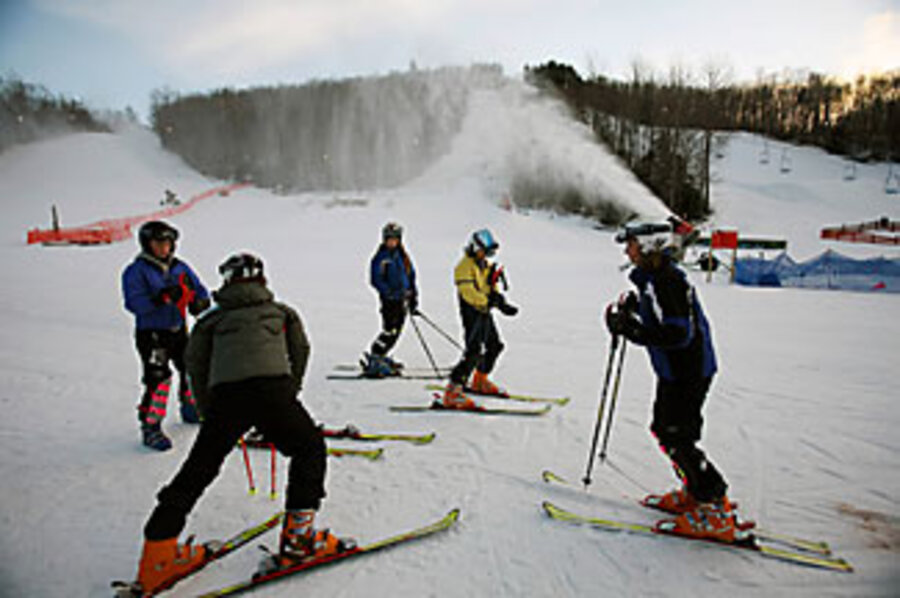A low-tech day on the slopes
Loading...
Every year, I scan the new batch of ski magazines. The covers and ads show the hottest ski destinations – Aspen and Steamboat Springs, Colo.; Jackson Hole, Wyo. Trim people wear color-coordinated outfits and carry matching skis. The clothing ads tell would-be skiers how they can look spectacular if they're willing to spend a fortune. Blue skies drape over snow-covered mountains behind the models. The weather is lovely; the people are sleek – and it is nothing like what I remember.
In the not-so-distant past, downhill skiing was a sport for the hardy. The lodges didn't necessarily have central heat or restaurants. High-tech fabric hadn't been invented.
I learned to ski in the old days, when skiing wasn't a fashion statement. My parents scraped together enough money to provide three children with ski lessons, and every Saturday we piled into the Chrysler and headed from the outskirts of Denver to Squaw Pass. For $9 a day, all three of us could own the mountain. That isn't too much of an exaggeration, since Squaw Pass was famously underpopulated.
I remember three main runs – green, blue, and black. A T-bar lift provided a challenge for beginners. For those who have never used one of these contraptions, a T-bar is just that – an inverted T suspended from a cable. Each T-bar held two people. A pair of skiers stood in tracks, and the lift pulled them up the hill. If one of the people got lazy and sat on the T, as my sister always did, the contraption dumped the sitter first and then the partner. The people on the next T usually landed on the pile until the lift operator noticed the problem and stopped the lift. It's not nearly as relaxing to be braced against an old T-bar in the stationary mode as it is to gently swing on a chairlift while waiting for a pileup to clear.
In those days, before microfiber and Gore-Tex, cotton long johns were the thing, followed by jeans and, for me and my brother, well-padded snow pants. On top, we packed on a couple of wool sweaters and a parka. The finished effect left us looking like gingerbread men, with arms outstretched and so overpadded they wouldn't come down. My older sister didn't have to bear the indignity of snow pants. She got to wear real ski pants such as the ones featured in the St. Moritz posters. It was only a few years later, when I inherited her old pair, that I found out the true misery of wearing this awful item of clothing.
Spandex was also a fabric of the future, and the original stretch pants had very little actual stretch, just constant, unrelenting pressure. Because the clothing was much less efficient then, the weather probably seemed far worse than it was. If you get cotton long johns wet – and I don't care how many layers of wool you have over them – you're going to get cold.
Our equipment seems quaint now, too. My boots were black – the only color available – and made of stiff leather with wide laces. They came just a little above the ankle. The skis were wood with cable bindings, and the proper length was the skier's height plus about a foot. If you crossed those tips three feet in front of you, you could pretty much count on a fall.
The skis weren't the chubby hourglass figures they are now, but long, straight missiles. We used leather safety straps to keep the skis attached to our legs in case one released during a fall. But it didn't stop safely in the snow; it bounced alongside the falling skier, whipping about like a huge nunchuck.
During breaks in the lodge at Squaw Pass, skiers gathered around a large central fireplace just long enough to get warm before hitting the slopes again, or they could sit on a log pulled up around a table made from a telephone cable spool. The snack bar sold hot dogs, potato chips, and hot chocolate.
Anyone who hung around the lodge too long risked being labeled a "snow bunny." But who wanted to hang around the lodge when there were hills to hurtle down? We crammed peanut butter and jelly sandwiches and chips in our parka pockets and ate on the lift.
Now when I ski, a comfortable chair lift with a footrest whisks me to the top of the mountain. Some of them even have windshields. There, lodges are so comfortable, that I could claim a corner in one and spend a week. A few layers of ultra-thin fabric keep me either warm or cool, depending on the conditions, and state-of-the-art equipment keeps me safe and looking competent.
Squaw Pass has been reinvented as Echo Mountain Park and caters to snowboarders. It has a triple chairlift, snow-making capabilities, and night skiing. The lodge has real tables and real food now. And the runs are wired for music. Sounds great, but a little part of me misses those old days, when the skiers were tough and only the tough went skiing.





